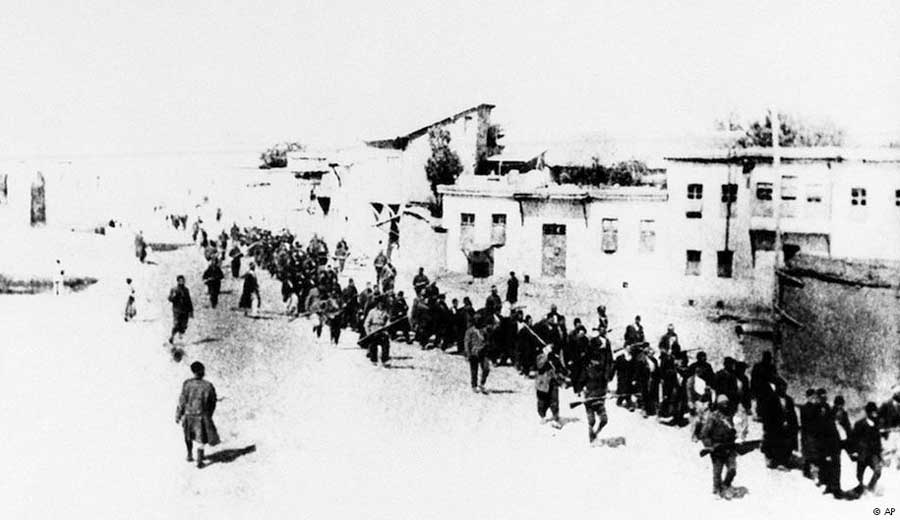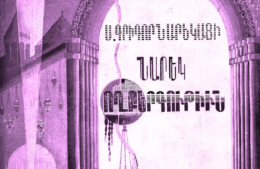New report details Germany’s role in Armenian Genocide
- (0)

The German Reich provided the Ottoman Empire with the weapons to carry out the Armenian genocide, a new report claims. Prussian officers also laid the “ideological foundations” for the massacre, according to the author, Deutsche Welle reports.
Turkish forces mainly used German rifles and other weapons to carry out the 1915-16 genocide of the Armenian people, a new report has found.
Mauser, Germany’s main manufacturer of small arms in both world wars, supplied the Ottoman Empire with millions of rifles and handguns, which were used in the genocide with the active support of German officers.
“German officers who served in Turkish-Ottoman military staff actively helped carry out individual murders,” the report by Global Net – Stop the Arms Trade (GN-STAT) said. “The majority of the aggressors were armed with Mauser rifles or carbines, the officers with Mauser pistols.” Many German officers witnessed and wrote about the massacres in letters to their families.
The report represents the first “case” being researched and developed by Global Net, a new multilingual worldwide network of over a 100 organizations, and a database for activists, whistleblowers, journalists, artists, and others interested in arms exports. It is already preparing new case studies about the illegal G36 deal that Heckler & Koch made in Mexico, and which is about to go to trial in Stuttgart, and the $110 billion (€90 billion) arms deal that the United States struck with Saudi Arabia last year.’
The Turkish army was also equipped with hundreds of cannon produced by the Essen-based company Krupp, which were used in Turkey’s assault on Armenian resistance fighters holding out on the Musa Dagh mountain in 1915.
In 2015, German President Joachim Gauck acknowledged Germany’s “co-responsibility” for the Armenian genocide, while a book published in the same year by journalist Jürgen Gottschlich detailed the political collusion of Turkey’s most important European ally in the first world war, which provided military advice and training for the Ottoman Empire throughout the Wilhelmine period. But the new GN-STAT report is the first to detail the sheer extent of the material support provided by Mauser and Krupp.
“Mauser really had a rifle monopoly for the Ottoman Empire,” said the report’s author Wolfgang Landgraeber, a filmmaker who has made several films about German weapons exports. Mauser is now defunct as a company, but Krupp’s successor, German steel giant ThyssenKrupp, has never publicly acknowledged the part it played in the genocide.
“The question of who actually supplied the weapons, not only for the genocide but also for the First World War in Turkey, no one has really addressed that question before,” said Landgraeber. “And to what extent German officers took part in murders by actually picking up the rifles and firing them themselves — that wasn’t known before.”
Many of the first-hand German accounts in the report come from letters by Major Graf Eberhard Wolffskehl, who was stationed in the southeastern Turkish city of Urfa in October 1915. Urfa was home to a substantial Armenian population, which had barricaded themselves inside houses against Turkish infantry. Wolffskehl was serving as chief-of-staff to Fahri Pasha, deputy commander of the fourth Turkish army, which had been called in as reinforcement.
“They (the Armenians) had occupied the houses south of the church in numbers,” the German officer wrote to his wife. “When our artillery fire struck the houses and killed many people inside, the others tried to retreat into the church itself. But … they had to go around the church across the open church courtyard. Our infantry had already reached the houses to the left of the courtyard and shot down the people fleeing across the church courtyard in piles. All in all the infantry, which I used in the main attack … acquitted itself very well and advanced very dashingly.”
While German companies provided the guns, and German soldiers the expert advice on how to use them, German officers also laid what Landgraeber calls the “ideological foundations” for the genocide.
Another figure the report focuses on is the Prussian Major General Colmar Freiherr von der Goltz, a key figure who became a vital military adviser to the Ottoman court in 1883, who saw himself as a lobbyist for the German arms industry and supported both Mauser and Krupp in their efforts to secure Turkish commissions. (He once boasted in his diary, “I can claim that without me the rearmament of the army with German models would not have happened.”)
“Not publicly, but among his friends and relatives, von der Goltz would show himself an Armenia-phobe,” said Landgraeber. “Several witnesses heard him describing them as ‘a greasy trader people.’ He helped persuade the Sultan to try and end the Armenian question once and for all.”
Landgraeber also considers von der Goltz a source for later Nazi ideology. The Prussian officer published a military book in 1883 entitled “Das Volk in Waffen” (“The People Armed”), in which, as Landgraeber puts it, “he adopts positions that Hitler would take up later — for example, the aim of a military campaign should be to destroy the enemy totally, not just to fight and force a capitulation. He believed in total war. That was also the ideological foundation that he gave the Ottomans, and which they used in the Armenian issue.”
Landgraeber is keen to underline that the new research does not absolve the Ottoman Empire of its guilt — but simply fills in the gaps in the historical record. “It happened as we have researched it, and nothing should be sugarcoated — but the entire picture should be more complete.”


















